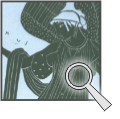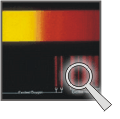Making
an Aurora
 The
aurora takes its name from the Roman goddess
of dawn, but its cause has nothing to do
with the Sun's light (early explanations even suggested that auroras were simply the reflections of light off of ice crystals in the atmosphere). The light from auroras
is actually similar to light produced by
a neon sign – some gases become excited
and glow when electricity passes through
them. The
aurora takes its name from the Roman goddess
of dawn, but its cause has nothing to do
with the Sun's light (early explanations even suggested that auroras were simply the reflections of light off of ice crystals in the atmosphere). The light from auroras
is actually similar to light produced by
a neon sign – some gases become excited
and glow when electricity passes through
them.
The
solar wind sometimes causes disturbances
in Earth’s magnetosphere. Auroras occur
when high-energy electrons from the magnetosphere
are guided by Earth's magnetic field towards
the polar regions and our atmosphere. There,
they collide with oxygen and nitrogen, atoms, electrically
exciting these gases so that they emit light,
much like the glow of a fluorescent lamp,
a neon sign, and even your TV.
Auroras Come in Different Colors
 Auroras
that are most often seen occur about 100-160
km (60-100 miles) above Earth's surface. Different
atmospheric gases emit different colors
of light when excited (i.e. they have a unique EM spectrum). The particular color
you see depends on the type of gas and
how much energy the electrons have when
they strike the ionosphere. Yellow-green
and red auroras are caused by excited oxygen.
Excited nitrogen is responsible for blue
and purplish auroras as well as some red
ones. The figure on the left compares light emitted from
the Sun (continuous spectrum) to one from an aurora (discrete
spectrum). Notice how different they are. Auroras
that are most often seen occur about 100-160
km (60-100 miles) above Earth's surface. Different
atmospheric gases emit different colors
of light when excited (i.e. they have a unique EM spectrum). The particular color
you see depends on the type of gas and
how much energy the electrons have when
they strike the ionosphere. Yellow-green
and red auroras are caused by excited oxygen.
Excited nitrogen is responsible for blue
and purplish auroras as well as some red
ones. The figure on the left compares light emitted from
the Sun (continuous spectrum) to one from an aurora (discrete
spectrum). Notice how different they are.
|